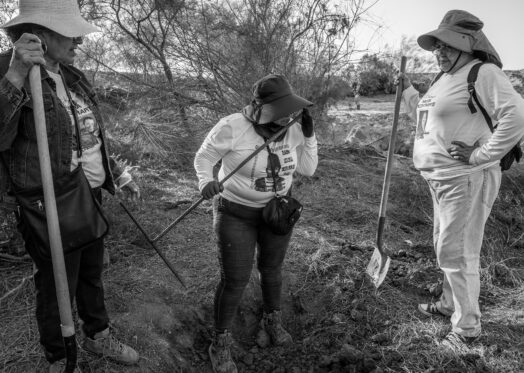Madres buscadoras

Searching for dead bodies in a state that is a stronghold for the Sinaloa cartel is not an easy task. Sicarios, the killers, are lurching in the corn fields, undeterred by the heavily armed police and army units. But mothers will risk their lives to find their loved ones. Or what is left of them: a skull, a jaw, a tooth, the tiny calcinated fragment of a bone. A few miles from Los Mochis, where El Chapo Guzmán was finally arrested in 2016, the search goes on in a dumping ground where more than 30 human remains have already been discovered: a fraction of the 114,000 Mexican desaparecidos.
Under a scorching sun a team of relatives of the disappeared, one of more than 60 groups of Madres buscadoras that have sprung up in this blood-stained nation, work from dawn to dusk with the help of shovels and pickaxes. They wear shirts with a promise: Te buscaré hasta encontrarte, I will search for you until I find you.
They scour the ground for signs: a raised patch of dirt, bullet shells, the unusual color of grass, pieces of cloth, grease in the soil, plastic bottles and tuna cans left around by persecutors. “We learned to be forensic archaeologists” grins Ceci Flores, founder of the Madres buscadoras de Sonora, who lost two sons, kidnapped and almost certainly murdered by drug cartels between 2015 and 2019. “We want to at least give our children a decent burial. We want to have a grave to cry over. That would be the job of the government, the judiciary, but they don’t give a damn. Everybody knows that the police and many politicians are involved in the killings”. To this day no one knows what happened to the 43 students from the Ayotzinapa rural school who disappeared in 2014 in the state of Guerrero: probably incinerated in an army crematorium.
The mothers have already discovered more than three thousand clandestine pits and mass graves with thousands of bodies and tens of thousands of human remains. They will never give up. They keep searching at the edges of streams, in garbage dumps, in swamps, on remote hills and mountains, in wells, in abandoned houses. A dozen of them were murdered. But the hope, and the pain, are pushing them to go on.
On their expeditions, they carry a varilla, a T-shaped, three feet long steel rod. When they dig a fresh hole they pierce the varilla into the ground, lift it, and smell the tip, hoping for the particular odor of death. This is how mothers search for their lost children in Mexico.





